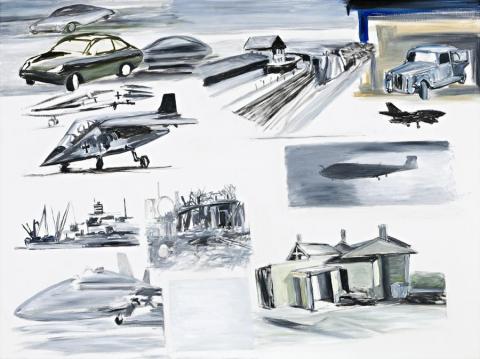FROM THE NEWSPAPERS NO. 2, 1998
KEN WHISSON
oil on linen
90.0 x 119.5 cm
signed, dated and inscribed verso: Ken Whisson / 12/4/98 & 30/5/98 / 31/5/95 & 5/6/98 / "From the Newspapers No. 2" ...
Niagara Galleries, Melbourne (label attached verso)
Private collection, Brisbane
Ken Whisson: As If, Heide Museum of Modern Art, Heide, 17 March - 15 July 2012, and Museum of Contemporary Art, Sydney, 28 September - 25 November 2012
Barkley G., and Harding, L., Ken Whisson: As If, Heide Museum of Modern Art, Melbourne and Museum of Contemporary Art, Sydney, 2012, cat. 147, pp. [92], 159 (illus., as 'From the Newspapers No. 1')
Although previously overlooked or marginalised as an 'outsider' within the annals of Australian art, today Whisson is universally celebrated as one of the most important and unconventional artists of our time. Based in Perugia, Italy since 1977, during his early years Whisson was a peripheral member of the group including Nolan, Boyd and Tucker who immersed themselves in the cultural ferment of the forties with John and Sunday Reed at Heide. Notably, he also studied with Cossack émigré artist Danila Vassilieff, under whose tutelage the younger artist not only embraced a predominantly expressionistic figurative style but gleaned a lifelong commitment to anarchism and non-conformity. Yet despite such seminal influences, the highly personal and unique vision that so distinguishes his mature work deliberately eludes affinity with any other artist or school. Rather, 'intuition' is the critical guiding force for Whisson, unleashing the creative impulse without prejudice or preconception to engage with a more fundamental reality. As the artist elucidates, 'style as presupposition blocks creativity ... art is far too complex to be thought and has to come from a whole complex of intuitive processes, from an intuitive focussing of memories, ideas, emotions, including seed and new beginnings left somewhere in the mind from past work. It comes from a focussing of all the different levels of consciousness.'1
Inextricably linked is Whisson's fervent belief that an artist 'must continually reinvent himself if he is to remain creatively fresh, thereby avoiding the pattern of a brief flowering and slow decline that has been the fate of so many well-known Australian painters.'2 Rejecting notions of skill or style 'that close one down', he reiterates that he has spent his entire life trying to 'avoid good technique' and to maintain 'a blank mind for a blank canvas' Encapsulating this pursuit of an art that is ever-evolving and far from predictable is the present composition which belongs to the surprisingly naturalistic series 'From the Newspapers', executed between 1998 and 2006. Featuring snapshots sourced from the Italian left-wing newspaper Il Manifesto, the work is punctuated with reportage-like images of battleships, helicopters and other emblems of a world at war. Indeed, while most commentators have tended to focus upon the expressive and formalistic peculiarities of his achievement, works such as From the Newspapers No. 2, 1998 powerfully highlight another dimension to Whisson's art - its connection with contemporary conditions and perceptions, inspired by the artist's enduring sense of deep social and political engagement with the world in which he lives.
1. Whisson, K., 'Technique and Intuition, Talk 1994' reproduced in Ken Whisson: Paintings 1947-1999, Niagara Publishing, Melbourne, 2001, p. 43
2. McDonald, J., 'Ken Whisson: Matter and Memory', cited ibid., p. 8
3. Whisson cited in Ken Whisson: Paintings 1957-1985, Broken Hill City Art Gallery, New South Wales, 1987, p. 18
VERONICA ANGELATOS
